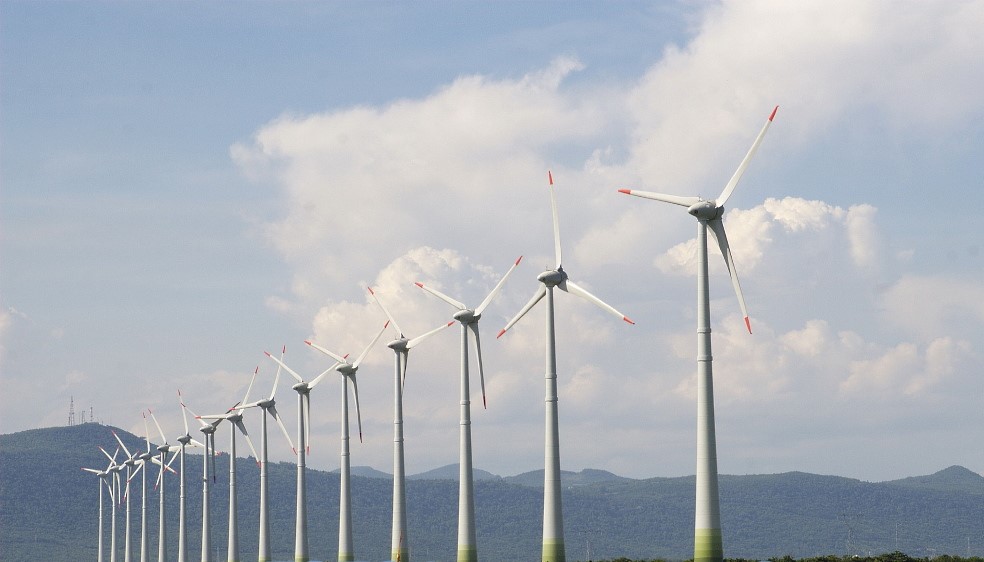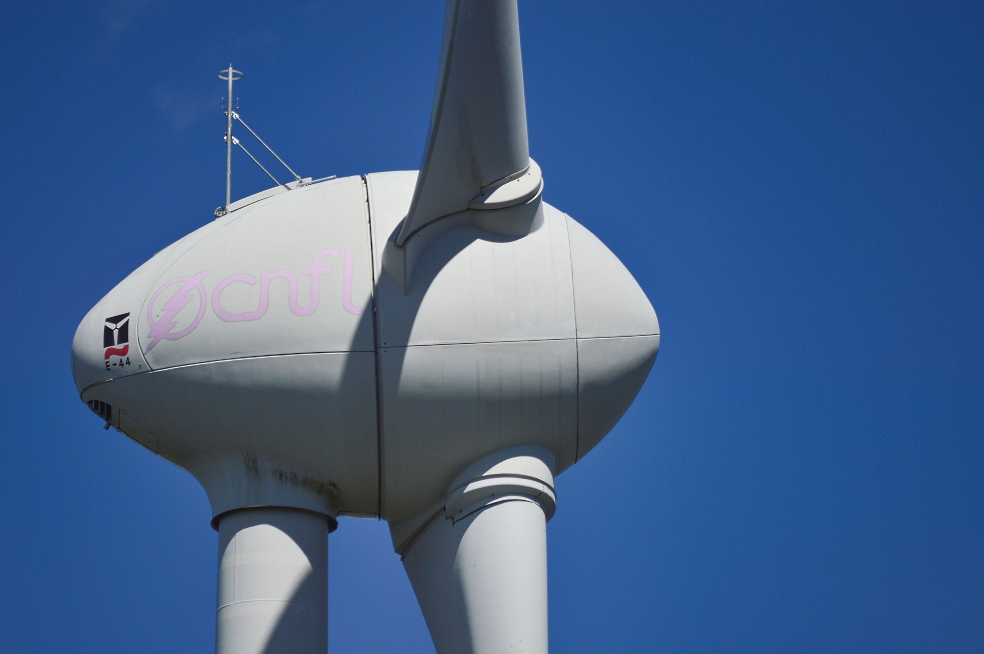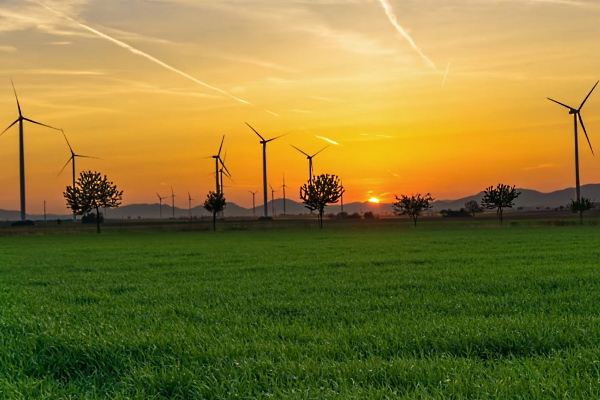After receiving the necessary documents and project presentation, our team will try to review your request as soon as possible, and leading experts will offer the best options for project funding.
Wind energy plays an increasingly important role in the country's energy sector. In 2019,
10% of all energy consumed in Brazil came from wind power plants, second only to hydroelectric power plants, which generated 64% of energy in the same period.
According to the Brazilian Wind Energy Association (ABEEólica), the newly installed capacity in 2019 reached 15.4 GW.
In recent years, 613 wind power plants and 7 536 wind turbines have been installed in the country.
Installed capacity is projected to grow to 40 GW over the next 10 years, which is the largest absolute growth among energy sources over this period.
In terms of costs, wind farms are ahead of other common sources of electricity in Brazil, such as HPPs and thermal power plants.
Wind farms are being installed in states and areas with challenging environmental conditions, gradually replacing dirty energy from fossil fuels.
Today, the situation is such that the high operating costs of thermal power plants and their dependence on dwindling fuel reserves are pushing TPPs out of the Brazilian electricity market. The construction of wind farms is getting cheaper, and low operating costs are an additional benefit for government customers and private investors.
Table: Current and projected installed capacity of wind power plants in Brazil from 2005 to 2023 (MW), according to Brazilian Wind Energy Association
| 2005 | 2006 | 2007 | 2008 | 2009 | 2010 | 2011 | 2012 | 2013 | 2014 |
| 27,1 | 235,4 | 245,6 | 346,2 | 606,2 | 933,0 | 1 529,4 | 2 523,3 | 3 478,4 | 5 973,9 |
| 2015 | 2016 | 2017 | 2018 | 2019 | 2020 | 2021 | 2022 | 2023 | |
| 8 727,7 | 10 741,6 | 12 768,6 | 14 707,5 | 15 865,0 | 16 740,3 | 16 926,1 | 18 533,8 | 19 670,1 |
Brazil has limitless wind energy potential, so the government expects wind energy to explode in the coming decades.
At the same time, about 90% of wind energy in Brazil is concentrated in the north-east of the country, where ideal natural conditions have been formed for using this energy source. In addition, this region of the country experiences a shortage of hydroelectric power plants.
Currently, Rio Grande do Norte and Bahia are the largest wind power producing states.
Wind power generation peaks in August-September.
This is known as the harvest of winds (safra dos ventos).
Figure: distribution of wind speed at an altitude of 50 meters in different regions of Brazil (blue indicates the highest wind speed, white - the lowest).
In the past, northeastern Brazil was dependent on thermal power plants for most of the year, but now wind power reduces this dependence.
Since this is a privileged region in terms of wind resources, engineering companies are actively exploring the possibility of building new wind energy facilities in the area.
It is planned to increase the installed capacity of wind farms by 20% over the next four years to meet the growth in energy consumption in the country. According to ABEEólica forecasts, by 2023 the total installed capacity will exceed 20 GW.

To support this growth, offshore wind farms, those that use wind power at sea, have been actively developed in Brazil since about 2015.
The sector is booming, offering investors significant technological advances and growing offshore wind turbine capacity.
In October 2019, US manufacturer GE announced the first contract in Brazil for the world's largest 5.3 MW onshore wind turbine. 25 turbines will be installed for the EDF Renewables wind farm in Bahia.
GE is also testing a 12 MW offshore turbine in France to market it next year.
All of these technologies contribute to more sustainable energy production.
Our team offers long-term project financing for wind farms in Brazil at attractive terms.
Wind farms in Brazil
Modern wind farms convert kinetic wind energy into electrical energy with high efficiency.These high-tech facilities, which consist of interconnected multi-megawatt wind turbines, are capable of replacing fossil fuel energy.
Wind power plants can be located on land or at sea, but are usually installed in uninhabited rural areas, far from settlements (noise and visual impact).
Other aspects to consider when designing a wind farm:
• Wind power resources of the region.
• Fluctuations in wind speed and direction throughout the year.
• Results of geological and geotechnical research.
• Potential impact of wind turbines on the environment.
• Economic viability of the project and more.
When constructing a wind farm, there are some issues to be considered related to its location.
The wind power plant should not be located in areas where birds migrate, as this can lead to their mass death as a result of collisions with the blades.
To build a wind farm in Brazil, an investor needs to carry out a series of special studies and prepare an environmental impact report (EIA / RIMA). This study will examine, among other things, noise pollution, as the blades of wind turbines generate a lot of noise.
Typically, wind farms in Brazil are built under an EPC contract.
This type of contract implies the full responsibility of a single contractor (usually a large engineering firm with an international reputation) for all stages of the project, from the feasibility study to the commissioning.
The EPC contract for the construction of a wind farm covers the following works:
• Conducting research and selecting a plot of land.
• Obtaining building permits and licenses.
• Earthworks and construction of access roads.
• Installation of a medium voltage line and construction of an electrical substation.
• Civil engineering (administrative building, workshops, etc.)
• Construction of foundations for the installation of wind turbines.
• Purchase, transportation and assembly of equipment on site.
• Testing and putting WPP into operation.
• Landscape restoration.
Choosing a site for the construction of a wind power plant
The site for the construction of a wind farm must meet a number of requirements and parameters.The choice of a site for the implementation of a wind energy project is always based on the results of a study of the wind regime, geological and geotechnical studies, an assessment of transport accessibility and an analysis of engineering work that will be required to prepare the site.
The selection of sites potentially suitable for construction requires compliance with some rules.
Assessment of wind resources
First, the maximum wind intensity is reached at the tops of mountains and hills, as well as in coastal areas.Secondly, areas with dense high-rise buildings and valleys between high hills are recommended to be avoided.
Areas most favorable for the construction of a wind farm can be identified using appropriate maps or by direct site visits.
The optimal site must meet the following requirements:
• Economic ability to connect to the power grid.
• Winds of sufficient intensity to obtain high profitability.
• Lack of complex orographic and topographic obstacles.
The assessment of wind resources is carried out on the basis of measurements at several points in the study area, for a period of 2-3 years. The study of wind requires detailed analysis from the point of view of the structure of the terrain, the roughness of the relief, natural and artificial obstacles.

As for the roughness of the relief, this parameter negatively affects the wind energy potential of the area.
Wind analysis for each site is done using a parameter called roughness class, where a region with many trees and obstacles (such as buildings) is considered to be highly rough (class 3 or 4), and roughness is considered 0 for the sea surface.
With regard to natural obstacles, it is important to know the type of obstacle, its location and dimensions. Trees, rock formations and buildings negatively affect the wind, reducing its speed and also creating turbulence. Therefore, engineering companies usually take into account all obstacles within a 1 kilometer radius of the wind turbine.
To measure wind characteristics in the study area, at least two meteorological towers are installed at the beginning and at the end of the wind farm.
It is important to place these meteorological towers in such a way that they reproduce the real operating conditions.
Geological and geotechnical research
Geological and geotechnical works are critical for the construction of a wind power plant.These studies are carried out in the early stages and include in the collection of data at the stage of making a decision on the continuation of the investment project.
The purpose of this stage is to define the characteristics of the soil in order to properly build the main infrastructure in relation to its interaction with the soil, to estimate costs and to ensure the safety and profitability of the facility.
Construction of access roads to the wind farm
The availability of suitable routes and access roads is essential for the transport of construction materials, equipment and wind turbine components.Therefore, engineers must take into account traffic, road width, pavement quality, road slope, turning radius and other parameters.
Typically, wind farms in Brazil are built in hilly areas where roads are winding and have small turning radii. This can make it difficult to transport equipment and machines using semi-trailers.
To overcome these difficulties, some roads have to undergo reconstruction and expansion and meet certain requirements. These measures may include relocating existing or building additional roads.
Changes to the existing roads are carried out taking into account that the length of vehicles can reach 35-40 meters, and the length of individual sections of wind turbine towers reaches 25-30 meters.
This imposes strict requirements on access roads, which must have a significant radius of curvature and a slope of no more than 10-12%.
Engineers pay particular attention to loading and unloading areas for heavy equipment, which must be properly leveled and reinforced. This may require removing the topsoil to a depth of 20 cm and strengthening the road base.
An important feature of the construction of a wind power plants in Brazil is a very humid climate, which contributes to the erosion of access roads during rains. Therefore, engineers should consider the arrangement of storm sewers and other means of protection.
Civil construction works
The most important part of the construction of any wind farm is civil construction work.This stage includes the arrangement of platforms, the construction of solid foundations at the construction site with the further installation of wind turbines and auxiliary equipment.
Platforms
The platforms are designed to provide adequate support to construction cranes for the assembly of multi-section wind turbines.They usually have a well-compacted surface with a solid base.
The platform dimensions depend on the type of crane used, which in turn is determined by the type of wind generator and the weight of the individual components.
Foundations
Insulated concrete foundations can be quite large.The dimensions and depth of the foundation depend on the characteristics of the wind turbine and tower, the composition of the soil and the expected loads on the foundation of the structure (wind, snow, ice).
Geological and geotechnical research is carried out in order to determine the ability of the soil of the area to withstand various loads. The use of a pile foundation is advisable in the case of low resistance soil, which transfers the load to deeper stable soil layers.
Cable trenches
The construction of trenches for laying power and control cables is part of a project to connect wind turbines to each other and to an electrical substation.These trenches should run parallel to the access roads. When trenches cross with access roads, high-strength cable routing pipes must be used that can support the weight of a heavy truck crane.
Main building and electrical substation
The construction of an office building and a electrical substation usually takes several months.As a rule, these works are performed simultaneously with works related to access roads, platforms, cable trenches and foundations.

This stage of construction work requires special experience and technology from the EPC contractor, especially with regard to the correct planning and installation of the electrical equipment of the substation.
In this case, a single company combines the competencies of a civil contractor and an electrical contractor.
Wind farm construction cost
The cost of building wind farms in Brazil varies widely, depending on the size of the facility, the equipment chosen, and the specifics of the construction site and its distance from the grid.Major construction costs include:
• Design work.
• Obtaining official permits.
• Construction of access roads.
• Excavation work and site arrangement.
• Construction of wind turbines.
• Construction of an electrical substation.
• Connecting generators to the distribution grid.
• Construction of auxiliary buildings.
• Development of the wind power plant infrastructure.
• Landscape restoration and environmental measures.
When comparing alternatives, a universal indicator is used, the cost per 1 MW of installed capacity. In most cases, each MW of installed wind farm capacity costs BRL ≈ 4-5 million.
These are approximate figures, each project is calculated individually and the cost depends on many factors.
Rating of the largest wind farms in Brazil
The distribution of wind power plants throughout the country is uneven, which is explained by significant differences in weather conditions, transport accessibility of sites and the availability of other types of energy.The northeast generates most of Brazil's wind power, with Rio Grande do Norte and Bahia being the largest states producing this key renewable energy.
The largest wind farms in Brazil are listed below by location and installed capacity.
Alto Sertao
The largest wind power project in South America consists of the Alto Sertao I and Alto Sertao II wind farms. The total installed capacity of these wind power plants exceeds 680 megawatts.The complex is located in the state of Bahia, on the Atlantic coast.
Alto Sertao I has 14 parks in the municipalities of Caetite, Igapora and Guanambi, with 184 wind turbines and an installed capacity of 294 megawatts.
This capacity is sufficient to supply the city with 540 thousand residential buildings.
The Alto Sertao II wind farm has a capacity of 386 megawatts and consists of 15 wind farms with 230 wind turbines installed in four municipalities. The total investment in both Alta Sertao wind farms exceeded BRL 2.6 billion.
The first capacities of the power plant began to be put into operation in 2012, but it was not possible to reach the planned capacity immediately due to the lack of substations and a distribution grid.
Delta 3
The powerful wind farm, which was built in the Brazilian state of Maranhao, is currently in eight stages.The total capacity of the wind power plant exceeds 220 MW, which provides about 13% of the electricity consumed by this state.
Delta 3 has 96 wind turbines, 48 in Barreirinhas and 48 in Paulinu Neves.
The last stages of the wind farm were commissioned in 2017. The total cost of the project was about BRL 1.5 billion.
Table: Top 10 largest wind farms in Brazil (existing and planned)
| Name | State | Installed capacity, MW |
| Complexo eolico Alto Sertao II | Bahia | 386 |
| Complexo eolico Alto Sertao I | Bahia | 294 |
| Complexo eolico Delta 3 | Maranyan | 221 |
| Usina de Energia Eolica Capao do Tigre | Rio Grande do Sul | 180 |
| Parque eolico Uniao dos Ventos | Rio Grande do Norte | 170 |
| Parque eolico de Osorio | Rio Grande do Sul | 150 |
| Parque eolico Morro dos Ventos | Rio Grande do Norte | 145 |
| Parque eolico de Agua Doce | Santa Catarina | 143 |
| Parque eolico Bons Ventos | Ceara | 138 |
| Parque eolico de Trairi | Ceara | 125 |
Do you need financing to build a wind farm in Brazil or Latin America?
The international company GCAM specializes in financing wind energy projects, providing the customer with a full range of services.
Contact us.




























